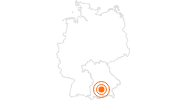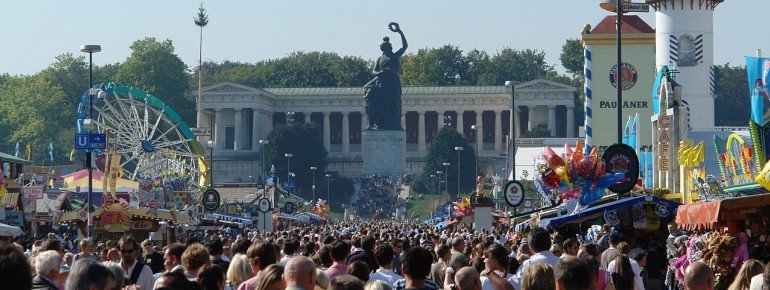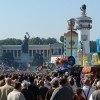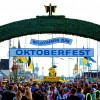Contents
Description
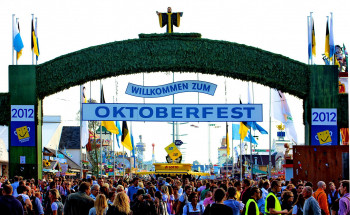
More than 6 million visitors flock to Munich's Theresienwiese every year for the world's largest Volksfest. A total of 200 showmen, almost 80 attractions and numerous beer tents await visitors at the Oktoberfest. Wearing traditional costumes like Dirndl and Lederhosen is part of the experience for many visitors.
For most people, visiting the Oktoberfest (aka Wiesn) means visiting one of the beer tents. In 17 large and 21 smaller beer tents you can enjoy a cool "Maß Wiesnbier". But be careful: For Oktoberfest, the Munich breweries produce a special beer that contains about 5.8 to 6.4 percent alcohol and is therefore much stronger than normal beer. Among the largest and most famous tents are the Löwenbräu, the Paulaner or the Hacker beer tent (also known as "The Bavarian Heaven"). Especially on weekends there is a lot going on in the tents. So if you don't have a reservation or prefere a more comfortable and quiet atmosphere, you should go to the Oktoberfest during the day instead of the evenings and during the week.
Away from the beer tents, numerous nostalgic and modern attractions and rides await visitors. Among the most famous are the "Todeswand", the "Zugspitzbahn", the "Toboggan", the "Teufelsrad", the "Schichtl", the "Hex'n Wipp'n", the "Olympia Looping" and of course the Ferris wheel. Every year, additional rides are added to keep the adrenaline level high for the visitors.
The Oide Wiesn
Whoever misses nostalgia and Bavarian cosiness in the hustle and bustle of the Oktoberfest will find the "Oide Wiesn" (=Old Wiesn) next to the Ferris wheel on the southern part of the Theresienwiese. Here historical rides like the "Kettenflieger Kalb" from 1919 await the visitors, as well as the three beer tents Tradition, Herzkasperlfestzelt and Zur Schönheitskönigin. Unlike at the big Oktoberfest you have to pay an entrance fee (4,- Euro) for the Oide Wiesn. But the rides cost only 1,- Euro.
The Oide Wiesn took place for the first time in 2010 and was actually only planned as a unique event for the 200th anniversary of the Oktoberfest. But because it was so well received by the people of Munich, it became a regular feature of the Wiesn. Every four years, however, it has to be suspended because the Oide Wiesn shares its place with the Bavarian Central Agricultural Festival.
Oktoberfest in September?
The festival begins in September due to the cool temperatures in October. The first Saturday after the 15th of September is the day of the barrel tapping, the end of the Wiesn is on the first Sunday in October. The exception is when the first or second of October is a Sunday. Then the festival is extended until the third of October, the Day of German Unity. Therefore, the Oktoberfest has a duration of at least 16, but at most 18 days.
Historical Information
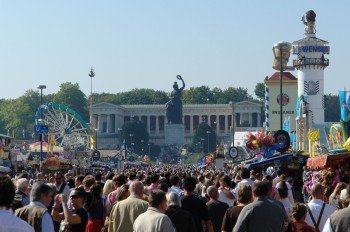
The beginning of a long tradition
The first prequel of the Oktoberfest took place on October 10, 1810. In honour of the wedding of Ludwig of Bavaria and Princess Therese of Saxony-Hildburghausen a horse race was held on the meadow (german: Wiese). This one was named after the bride: Theresienwiese.
A year later they agreed that the party had to go on. Therefore another celebration with horse races and presentations of the rural achievements took place on the Theresienwiese. In 1813 the festival had to pause for the first time due to the Napoleonic wars. In the following years, the Wiesn was held as a privately financed celebration and since 1819 has finally been in the hands of the City of Munich. In the course of time more and more showmen, carousels and stalls were added. The Oktoberfest became a folk festival (Volksfest).
In 1850 the 18.50 meter high statue "Bavaria" was unveiled. She is the patron saint of Bavaria and has been watching over the Oktoberfest ever since. In addition to the bronze statue, parts of the Hall of Fame were inaugurated. Over the years, the festivities took on the character of a folk festival. Larger beer tents, merry-go-rounds, showmen and music bands provided entertainment and hospitality for the visitors.
The Oktoberfest in the 20th century
In 1910 the Wiesn celebrated its 100th anniversary. The largest tent offered space for 12,000 people and more and more rides were opened. However, the Oktoberfest had to be cancelled several times during the First and Second World Wars and inflation in the 1920s. Smaller autumn festivals should minimize the loss. In 1949 the first Oktoberfest after the wars took place, horse races were only held again for the 150th and 200th jubilee.
Munich's then Mayor Thomas Wimmer tapped the first Oktoberfest barrel in 1950. This was the birth of a tradition that continues to this day: Each Oktoberfest opens with the tapping of the first barrel by the acting Mayor and the words "O'zapft is".
How to get there

By car
Munich is located on the motorways A8, A9, A92, A94, A95, A96 and A99. If you want to park in the centre, follow the parking guidance system. Another possibility is the use of Park+Ride stations in the surrounding area. From there you can take the bus or S-Bahn to Wiesn.
With the bus
If you want to travel to Munich by long-distance bus, you can reach the station at the Hackerbrücke with many lines from Germany and abroad. The Theresienwiese is just a few minutes' walk from the bus stop. The way there is signposted.
With public transport
Munich Airport is located just outside the city center. The S-Bahn lines 1 and 8 travel at regular intervals between the airport and the main stops in the city centre.
If you take the train to the Bavarian capital, the main station is your destination. From there the underground lines U4 and U5 go directly to the station "Theresienwiese".
On foot you walk about ten minutes from the main station to the Oktoberfest. You leave the station building at the Bayerstraße exit. Follow the road for about 300 meters and turn left into Hermann-Linger-Straße. After another 400 metres you will reach the Theresienwiese.
